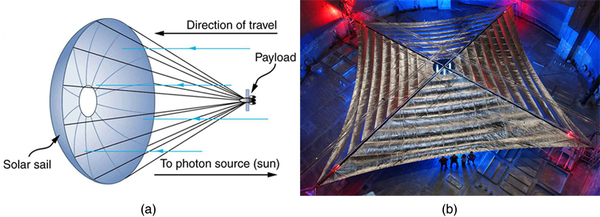| << Chapter < Page | Chapter >> Page > |

There is a relationship between photon momentum and photon energy that is consistent with the relation given previously for the relativistic total energy of a particle as . We know is zero for a photon, but is not, so that becomes
or
To check the validity of this relation, note that for a photon. Substituting this into yields
as determined experimentally and discussed above. Thus, is equivalent to Compton’s result . For a further verification of the relationship between photon energy and momentum, see [link] .
Almost all detection systems talked about thus far—eyes, photographic plates, photomultiplier tubes in microscopes, and CCD cameras—rely on particle-like properties of photons interacting with a sensitive area. A change is caused and either the change is cascaded or zillions of points are recorded to form an image we detect. These detectors are used in biomedical imaging systems, and there is ongoing research into improving the efficiency of receiving photons, particularly by cooling detection systems and reducing thermal effects.
Show that for the photon considered in the [link] .
Strategy
We will take the energy found in [link] , divide it by the speed of light, and see if the same momentum is obtained as before.
Solution
Given that the energy of the photon is 2.48 eV and converting this to joules, we get
Discussion
This value for momentum is the same as found before (note that unrounded values are used in all calculations to avoid even small rounding errors), an expected verification of the relationship . This also means the relationship between energy, momentum, and mass given by applies to both matter and photons. Once again, note that is not zero, even when is.
Note that the forms of the constants and may be particularly useful for this section’s Problems and Exercises.
Which formula may be used for the momentum of all particles, with or without mass?
Is there any measurable difference between the momentum of a photon and the momentum of matter?
Why don’t we feel the momentum of sunlight when we are on the beach?
(a) Find the momentum of a 4.00-cm-wavelength microwave photon. (b) Discuss why you expect the answer to (a) to be very small.
(a)
(b) The wavelength of microwave photons is large, so the momentum they carry is very small.
(a) What is the momentum of a 0.0100-nm-wavelength photon that could detect details of an atom? (b) What is its energy in MeV?
(a) What is the wavelength of a photon that has a momentum of ? (b) Find its energy in eV.
(a) 13.3 μm
(b) eV
(a) A -ray photon has a momentum of . What is its wavelength? (b) Calculate its energy in MeV.
(a) Calculate the momentum of a photon having a wavelength of . (b) Find the velocity of an electron having the same momentum. (c) What is the kinetic energy of the electron, and how does it compare with that of the photon?
(a)
(b) 291 m/s
(c) electron , photon , ratio
Repeat the previous problem for a 10.0-nm-wavelength photon.
(a) Calculate the wavelength of a photon that has the same momentum as a proton moving at 1.00% of the speed of light. (b) What is the energy of the photon in MeV? (c) What is the kinetic energy of the proton in MeV?
(a)
(b) 9.39 MeV
(c)
(a) Find the momentum of a 100-keV x-ray photon. (b) Find the equivalent velocity of a neutron with the same momentum. (c) What is the neutron’s kinetic energy in keV?
Take the ratio of relativistic rest energy, , to relativistic momentum, , and show that in the limit that mass approaches zero, you find .
and , so
As the mass of particle approaches zero, its velocity will approach , so that the ratio of energy to momentum in this limit is
which is consistent with the equation for photon energy.
Construct Your Own Problem
Consider a space sail such as mentioned in [link] . Construct a problem in which you calculate the light pressure on the sail in produced by reflecting sunlight. Also calculate the force that could be produced and how much effect that would have on a spacecraft. Among the things to be considered are the intensity of sunlight, its average wavelength, the number of photons per square meter this implies, the area of the space sail, and the mass of the system being accelerated.
Unreasonable Results
A car feels a small force due to the light it sends out from its headlights, equal to the momentum of the light divided by the time in which it is emitted. (a) Calculate the power of each headlight, if they exert a total force of backward on the car. (b) What is unreasonable about this result? (c) Which assumptions are unreasonable or inconsistent?
(a)
(b) Headlights are way too bright.
(c) Force is too large.

Notification Switch
Would you like to follow the 'Basic physics for medical imaging' conversation and receive update notifications?